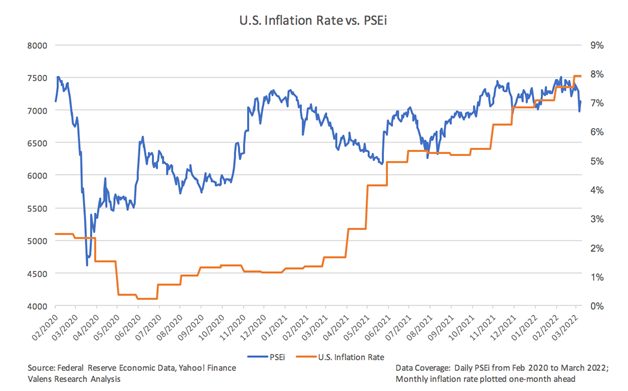MONDAY MACRO: Should Filipino investors be concerned about unprecedented spikes in U.S. inflation rates?

Current U.S. inflation levels are at highs that haven’t been seen for four decades, and the Philippine market is trying to understand what this would mean for our economy.
In today’s article, we talk about whether this should be a point of concern, especially in the long term.
Philippine Markets Newsletter:
The Monday Macro Report
Powered by Valens Research
The U.S. Federal Reserve, more commonly referred to as the Fed, is in charge of stabilizing inflation through interest rate adjustments and other tools. Its role is especially important today as inflationary pressures caused by a mix of macroeconomic headwinds plague the U.S. economy.
Specifically, U.S. inflation continued to rise in 2022, shooting up to a 40-year high rate of 7.9% in February 2022 from 7.5% in the month before.

This is a classic case of soaring inflation caused by a supply-and-demand imbalance—but this time, magnified to alarming levels due to unprecedented events. The pandemic created a slew of global supply chain issues that did not mix well with robust consumer demand from an increased flow of pandemic-related federal aid for Americans.
There were other factors, however, that also came into play, including low interest rates that were set initially to revitalize demand at the beginning of the pandemic lockdowns as well as worker shortages.
Currently, the Fed is on track to hike up interest rates in order to better manage elevated inflation levels, and could possibly hike up rates later in the year.
If you recall, one way the Fed adjusts interest rates is through quantitative easing (QE), which we saw was used after the 2008 Great Recession. It was a way to inject liquidity into the economy by directly purchasing securities in the open market.
The Federal Open Market Committee (FOMC) is also working on quantitative tightening (QT) policies—the counterpart to QE—by reducing bond purchases, and even selling securities in order to shrink its balance sheet and overall reduce money supply and liquidity in the market.
All said, how does the U.S. having high inflation rates affect the Philippine stock market?
While Philippine inflation does not move together with U.S. inflation, the Philippine stock market reacts to changes in the U.S. economy that could potentially impact the global market.
As an illustration, PSEi shares dipped by 0.59% in November following the U.S. posting inflation rates rising to 30-year highs. U.S. inflation rates have continued to move up since to 40-year high levels of 7.5% in January, causing the PSEi to fall by 2.18%.
Investors are worried that the Fed’s aggressive interest rate hikes response could further tighten global financial conditions and put a damper on economic growth, particularly in emerging markets such as the Philippines.
To be more specific, an increase in U.S. interest rates would likely strengthen the U.S. dollar (USD) all else equal. For the Philippines, this could mean fund flows moving from the country to the U.S. as well as a weakening of the Philippine peso (PHP) relative to the USD.
That said, BSP Governor Diokno stated that the BSP “need not move in lockstep with the Fed” and that he would maintain low interest rates despite U.S. rate hikes.
Furthermore, it’s worth noting that inflationary pressures (particularly in pork and oil) in the country are caused mainly by supply-side factors, unlike in the U.S. where demand is also a significant contributor. This is why BSP Governor Diokno said that local inflationary pressures would be better addressed by non-monetary policy changes.
On that note, as mentioned, current headwinds are caused mainly by unprecedented events. As the economy continues to reopen and return to pre-pandemic levels, longer-term inflation and interest rate expectations are likely to remain low.
So while short-term U.S. interest rate hikes as a response to inflationary pressures would impact Philippine capital flows and currency strength, it shouldn’t cause too much concern once U.S. inflation rates stabilize back to normal target levels.
With that, local equity investors shouldn’t worry too much about rising U.S. inflation and interest rates in the long term and should continue to focus on company fundamentals.
About the Philippine Markets Newsletter
“The Monday Macro Report”
When just about anyone can post just about anything online, it gets increasingly difficult for an individual investor to sift through the plethora of information available.
Investors need a tool that will help them cut through any biased or misleading information and dive straight into reliable and useful data.
Every Monday, we publish an interesting chart on the Philippine economy and stock market. We highlight data that investors would normally look at, but through the lens of Uniform Accounting, a powerful tool that gets investors closer to understanding the economic reality of firms.
Understanding what kind of market we are in, what leading indicators we should be looking at, and what market expectations are, will make investing a less monumental task than finding a needle in a haystack.
Hope you’ve found this week’s macro chart interesting and insightful.
Stay tuned for next week’s Monday Macro report!
Regards,
Angelica Lim
Research Director
Philippine Markets Newsletter
Powered by Valens Research
www.valens-research.com




